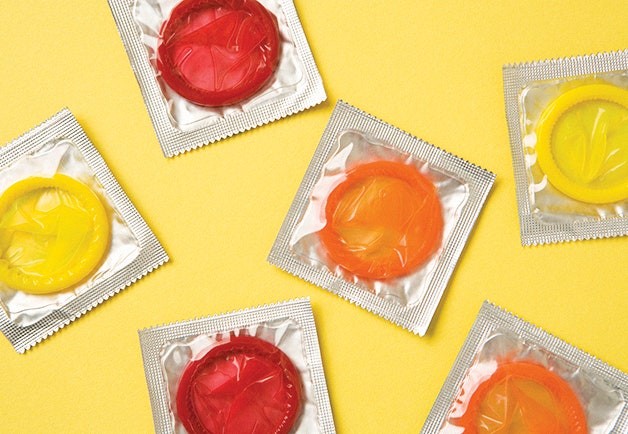
Contents
- 1 Quiz: What Is the Truth About Condoms?
- 1.1 Condoms are the most effective form of birth control.
- 1.2 Condoms are the best option for people at risk of HIV and sexually transmitted diseases (STDs) to prevent infection.
- 1.3 The most common reason for condom failure is breakage.
- 1.4 What materials are condoms made of?
- 1.5 Condoms are "one size fits all."
- 1.6 As long as the package is not opened, condoms can be stored indefinitely.
- 1.7 To properly use a male condom …
- 1.8 To properly use a female condom…
Quiz: What Is the Truth About Condoms?
Condoms are a type of barrier method of birth control used to prevent sperm from entering the uterus and are meant to be used each time you have sex.
Male condoms that cover the penis and female condoms that are inserted into the vagina are the only types of barrier birth control that can protect against sexually transmitted diseases (STDs).
A method of birth control A way to help prevent sexually transmitted disease (STD) Both A & B Only A
Condoms are the most effective form of birth control.
Condoms are not the most effective form of birth control and are best used along with another form such as an IUD, implant, or shot.
The only 100% reliable method that can prevent pregnancy is abstinence, which means avoiding any sexual activity in which sperm can get near or into a vagina.
The next most effective form of birth control is surgical sterilization, either a tubal ligation ("tubes tied"), sterilization implant, or hysterectomy (removal of the uterus) in women, or a vasectomy in men.
The most effective reversible form of birth control is long-acting reversible contraception (LARC) such as an intrauterine device (IUD) or implant plus a condom.
Hormonal birth control methods such as birth control pills are also very effective in preventing pregnancy when used perfectly.
True False
Condoms are the best option for people at risk of HIV and sexually transmitted diseases (STDs) to prevent infection.
In addition to helping prevent pregnancy, consistent condom use has been shown to reduce human immunodeficiency virus (HIV) transmission significantly. It is recommended that condoms be used by people at risk for contracting human immunodeficiency virus (HIV) and sexually transmitted diseases (STDs) even if they already use other methods of birth control.
Condoms are 98% effective at protecting against most STDs including chlamydia and gonorrhea but condoms don’t always protect against herpes, genital warts, and syphilis which can be spread from skin-to-skin contact.
True False
The most common reason for condom failure is breakage.
Condom failure is not usually caused by breakage, but inconsistent or incorrect use, such as:
- Failure to leave space for ejaculate at the tip of a condom
- Removing a condom before completing intercourse
- Putting a condom on too late
- Use of oil-based lubricants that can damage the condom
- Inexperience with use
- Not being careful with use
True False
What materials are condoms made of?
Condoms are made of a variety of materials, such as:
- Latex
- Most external condoms in the U.S. are made from latex, a substance derived from rubber trees
- They come in a wide variety of brands and types and are the least expensive
- Can only be used with water- or silicone-based lubricants (no oil, petroleum jelly, or lotion)
- Polyurethane
- Made from a material similar to plastic
- Recommended for people who are allergic to latex
- Used with water- or silicone-based lubricants
- A newer type of non-latex external condom
- Used with water-based or silicone-based lubricants
- Lambskin
- Made from the intestine of a lamb
- They can reduce the risk of pregnancy but do not reduce the risk of sexually transmitted diseases (STDs) or human immunodeficiency virus (HIV) transmission
- Can be used with both water- and oil-based lube
- The most expensive type of condom
- Internal condoms (female condoms), made from another synthetic rubber material
- Compatible with water-, silicone-, or oil-based lubricants
Latex Polyurethane Lambskin All of the above
Condoms are "one size fits all."
Condoms are not one-size-fits-all and size matters. A poorly fitted condom increases the risk of unplanned pregnancy or transmitting sexually transmitted diseases (STDs).
Signs a condom may be the wrong size include:
- Condom breaks
- Condom slips off
- Condom restricts sensations during intercourse
Condom sizes are determined by the circumference of the penis, not the length, though there are extra-long condoms for men who have very long penises.
True False
As long as the package is not opened, condoms can be stored indefinitely.
Male condoms can be stored for three to five years, while female condoms can be stored for up to five years.
Male condoms should be kept away from extreme temperatures (above 104°F/40°C), moisture and humidity, direct sunlight or fluorescent light, and ozone.
Female condoms are made from polyurethane, and are not affected by humidity and ozone levels. They do not require special storage conditions.
Condoms should be discarded once they have expired.
True False
To properly use a male condom …
It is important to use a condom consistently and correctly each time. Incorrect or inconsistent use can lead to unwanted pregnancy or transmission of sexually transmitted diseases (STDs).
- Use a new condom for every sexual act
- Put the condom on the tip of the erect penis with the rolled side out before genital contact occurs
- If the condom does not have a reservoir tip, pinch the tip to ensure a half-inch space to collect the semen
- Hold the tip and unroll the condom to the base of the erect penis
- Use adequate and appropriate lubrication such as water-based lubricants during vaginal and anal sex
- Oil-based lubricants (e.g., petroleum jelly, shortening, mineral oil, massage oils, body lotions, and cooking oil) can weaken latex and cause breakage
- After ejaculation and before the penis gets soft, grasp the rim of the condom at the base of the penis and carefully withdraw
- Gently remove the condom from the penis, ensuring that semen doesn’t spill out
- Wrap the condom in a tissue and dispose of it where others won’t handle it
- If you feel the condom break at any point, stop immediately, withdraw carefully, remove the broken condom, and put on a new condom
Use a new condom for each act of sex Leave a half-inch space in the tip to collect semen Ensure adequate and appropriate lubrication is used during sexual activity All of the above
To properly use a female condom…
Female condoms are also called internal condoms, because they are inserted into the vagina prior to sexual activity. They are a barrier method just like male condoms. Female condoms should be used on their own. Using a female condom with a male condom could result in tearing.
There is a thick, inner ring with closed end that is used to place the condom in the vagina and to hold it in place. A thin, outer ring remains outside of body, covering vaginal opening.
- Use a female condom from start to finish, every time you have vaginal sex
- Hol the outside of the condom at the closed end, and squeeze the sides of the inner ring together with the thumb and forefinger and insert into the vagina, similar to inserting a tampon
- Using a finger, push the inner ring as far up as it will go until it rests against cervix
- The condom will expand though you may not feel it
- Ensure condom is not twisted and that the thin, outer ring stays outside the vagina
- Stop intercourse if the penis slips between condom and walls of the vagina or if the outer ring is pushed into the vagina
- To remove, gently twist outer ring and remove the condom from the vagina
Use it with a male condom Make sure the thin, outer ring is just inside the vagina Use a female condom from start to finish, every time you have vaginal sex Use plenty of lubrication
Images provided by:
1. iStockPhoto
2. iStockPhoto
3. iStockPhoto
4. iStockPhoto
5. iStockPhoto
6. iStockPhoto
7. iStockPhoto
8. iStockPhoto
9. iStockPhoto
Government of Western Australia Department of Health. Do condoms protect against all STIs?
Minnesota Department of Health. Condom Storage and Distribution Guidelines.
This tool does not provide medical advice. See additional information:
THIS TOOL DOES NOT PROVIDE MEDICAL ADVICE. It is intended for general informational purposes only and does not address individual circumstances. It is not a substitute for professional medical advice, diagnosis or treatment and should not be relied on to make decisions about your health. Never ignore professional medical advice in seeking treatment because of something you have read on the MedicineNet Site. If you think you may have a medical emergency, immediately call your doctor or dial 911.
© 1996-2024 MedicineNet, Inc. All rights reserved.


